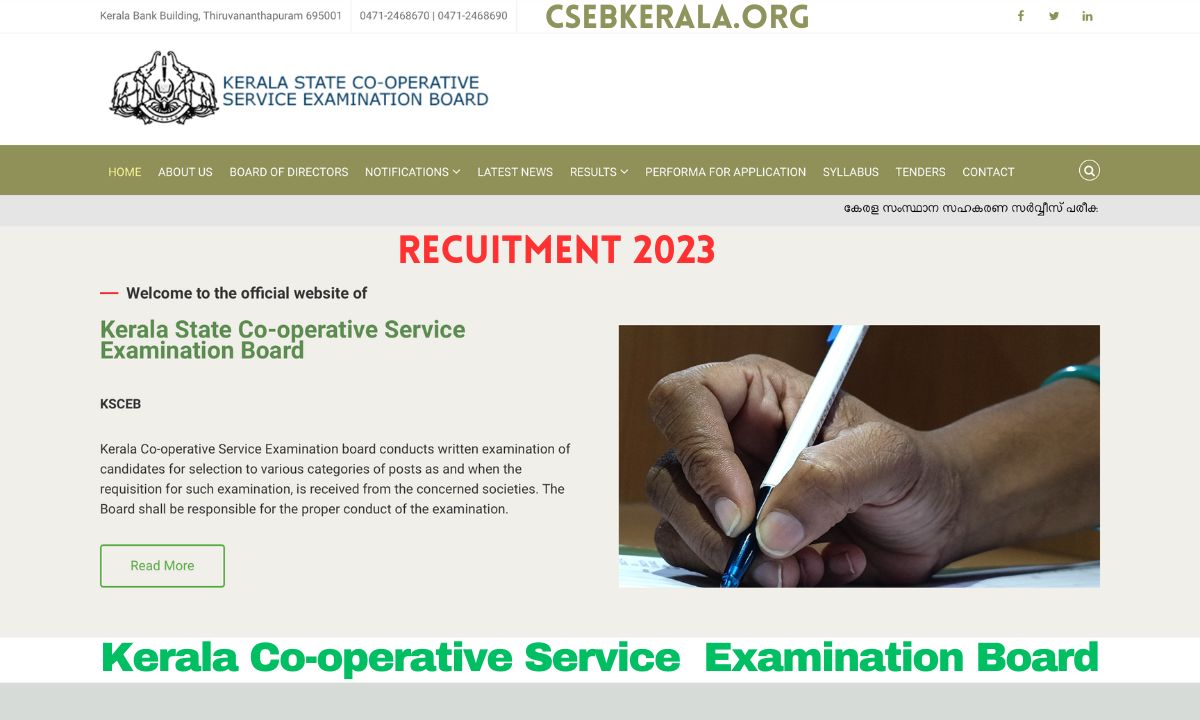The Kerala Co-operative Service Examination (CSEB Kerala) is a Test Conducting body which Is Responsible for the Selection of Eligible Candidates for the Co-operative Sector as per the requisitions put up by various societies. The KeralaCSEB organises various Examinations for the selection of Candidates for Various posts like Assistant Clerks, Data Entry Operators, Clerks etc. The Board is Responsible for the declaration of Results, Answer key, Merit List and release Notification for the Recruitment Exam. The Kerela CSEB Ensures the conduction of Fair, Transparent and clear Instructions for the Candidates.
The Kerala Co-operative Service Examination Board Ensure Fair Examination practice by Providing Equal Opportunities for the Applicants. The Syllabus for the Examination is Designed by the Board and the Recutritment Examinations are Conducted based on this Syllabus, And The Syllabus is formed by consulting with Experts and professionals Aim to Check the Skill, Knowledge and Aptitude of the Candidates and is required for the Position in the Co-operative Sector.CSEBKerala plays Major Role In the Recruitment And Deployment of Qualified Candidates to the various Co-operative Services which Ensure the Smooth Functioning of the Board
CSEB Kerala Recuitment 2023
The CSeb Kerala i.e. Kerala Co-operative Service Examination Board has released a notification for the recruitment of candidates for Various posts. Interested Students can Apply for the Same On the official website of CsebKerala. Before Moving For forward and Applying, candidates are Advised to Read the official Recuitment Notification Carefully. Kerala Co-operative Service Board has announced recruitment notification for the Various Post Like Secretary, Chief Accountants, Clerks Etc.
Kerala State Co-Operative Service Examination Board (CSEB) has released a official notification to fill the vacancy of Junior Clerk, Assistant Secretariat, System Admin, and Data Entry Operator on about 156 Posts Through Offline Mode.So those Aspirants who Want to Apply for the Posts can do so by Visiting the Official Website of Co-Operative Services Examination Board, Kerala.
Kerala State Co-Operative Service Examination Board (CSEB) Overview
| Board | CSEB Kerela |
| Name | Kerala Co-operative Service Examination Board |
| State | Kerala |
| Post | Various Post |
| Exam Year | 2023 |
| Application Start Date | 24 April 2023 |
| End Date | 24 May 2023 |
| Exam Date | July 2023(expected) |
| Result | TBA |
| Notification | TBA |
| Merit List | TBA |
| Syllabus | Available |
| Official website | csebkerala.org |

Kerala CSEB Notification & Exam Date
The CSEB Kerala Has Release The official Notification for the Recruitment of various Post and The Candidates can Apply for the post on the Website The Application process will begin on 24 April 2023 and the Applicant can Apply till the Last date of Registration which was 26 May 2023. The Examinations Will be Conducted soon and According to News Sources, the Exam may be Conducted in July 2023. The Applicant will be able to download the Admit Card i.e. Hall ticket One Week Before the Exam and Announce the Exam Date on the Official website i.e.csebkerala.org.
CSEB Kerala Answer Key 2023
The Answer Key for Various Recruitments of Kerala CSEB like Assistant Secretary, Junior Clerk and Various Posts are Released after the Successful Completion of the Exams. The candidates who have Attempted the Examination can have an idea about their marks and Overall Performance by Downloading the Answer Key from the Official Website.
Notifications::
- Urgent Loan 50000:[Apply Now] कोई भी जरुरत तुरंत होगी पूरी, जीरो सिबिल पर भी Instant Loan
- $1200 Per Month April 2024 Adult Check, Eligibility & Payment Release Date
- Compact Solar Pump Subsidy 2024, किसानों को 95% सब्सिडी पर 3, 5 और 7.5HP के सोलर पंप , ऑनलाईन आवेदन शुरु
- RBSE Class 10th Result 2024 , Download scorecard @rajeduboard.rajasthan.gov.in
- Improve CIBIL Score Affected Via Credit/Debit Card:सिबिल स्कोर सुधारने के सबसे आसान तरीके [Tricky Ideas]
- Personal Loan for CIBIL Score of 550-600:ख़राब सिबिल स्कोर पर लोन, अपनाएं ये सेफ ट्रिक यहां से मिलेगा लोन
- PM Kisan 17th Kist e-KYC Last Date, beneficiary List Villagewise
- DC vs SRH Prediction 2024, Pitch Report, Playing 11, Dream Team
- JAC Class 10th Results 2024, Topper List Namewise @jacresults.com/
- PSEB Class 10th Result 2024, Released @pseb.ac.in, Check Topper’s List
- Telangana State Inter Results Date 2024, Topper List Released Date Namewise @tsbie.cgg.gov.in/
- HPBOSE Class 10th Result 2024 Released Date, Check Topper List (Direct Link) @hpbose.org/
- AP SSC Result 2024 Released Date, Check Scorecard Via Name @bse.ap.gov.in/
- PM Kisan 17th Kist Release Date 2024, Check Beneficiary list & Last to Complete eKYC
- MP Board 10th & 12th Result 2024, Released Check through Roll Number and Name @mpbse.nic.in [Direct Link]
The Answer Keys for all the Posts are Released on the website keralacseb.kerala.gov.in and the Link to Download the Answer Key will also be available on the Portal. The Students should follow the Instructions and can raise any objections if they have any doubts about the Official Answer Key.
CSEB Kerala Result 2023
The Examinations date for the Recruitment Will be soon released. After the Successful conduction of the CSEB Kerala Examination 2023, The Board evaluate the Answer sheet of the Applicant and Prepare the result as per the Performance in the Examination. The CSEB Kerala Will Ensure the Evaluation of the Answer sheet is done properly without Partiality. The Result will Be made Available for the Candidates on the official Website i.e. Csebkerala.org. The Candidates can Check the Result through their Registration Number and Password.
Candidates are advised to Visit the Homepage Toggle on the Result Icon and Clicked on the desired Examination Result Link. The result can be viewed or Download by
CSEB Kerala Merit List PDF
Once the Results are Released the Board Prepare the Merit List for the Qualified Candidates. The Merit Lis are Prepared based on the Candidate’s Performance in the Examination. The Candidates who qualify for the Merit List are Called for further Examination Procedure Like Skill tests, Interviews. The CSEB Kerala Merit List 2023 Will be Release Soon after the Results are Released, The Candidates are advised to check the Official website for any updates regarding the Recruitment Status
Kerala CSEB Posts Eligibility & Syllabus
The CSEB Kerala Organises and Releases The Result of the Examination conducted, The Board Is also Responsible for the Designing Syllabus of Recruitment Posts. The Syllabus Differs According to the Vacancy. The Main Objective of the CSEB Kerala Syllabus is to Hire Skilled and qualified professionals. The Syllabus is Periodically updated and Changed according to the Latest Demands and requirements of the Co-operative Industry.
The Applicants Check the Qualifications of Various Post Below:-
| Post Name | Qualification |
| Assistant Secretary | Higher Secondary Diploma in Co-operative University (HDC or HDC & BM of Kerala State Co-operative Union, or HDC or HDCM of National Council for Co-operative Training) with at least 50% marks in all subjects. Must have passed Subordinate Personal Co-operative Training Course (Junior Diploma in Co-operation).Or BSc / MSc from Kerala Agricultural University or B.Com degree with at least 50% marks in all subjects recognized by any university in Kerala and co-operation is optional. |
| Junior Clerk/ Cashier | SSLC or equivalent qualification will be the basic qualification for the Subordinate Personal Co-operative Training Course (Junior Diploma in Co-operation).Candidates from Kasaragod District will be eligible for the post of Co-operative Diploma Course (JDC) conducted by the Karnataka State Co-operative Federation (JDC) and Junior Diploma in Co-operation (JDC) conducted by the Kerala State Co-operative Union.In addition, a B.Com degree in Co-operation as an optional subject, or a degree in Co-operative Higher Diploma from any recognized University (HDC or HDC & BM of the Kerala State Co-operative Union, or HDC or HDCM of the National Council for Co-operative Training). Candidates who have successfully completed Subordinate Personal Co-operative Training Course (Junior Diploma in Co-operation) or BSc from Kerala Agricultural University can also apply. |
| System Administrator | First class B.Tech degree in Computer Science, IT, Electronics and Communication Engineering / MCA / MSc (Computer Science or IT). Desirable : Redhat Certification will be an added advantage. EXPERIENCE : Minimum working experience of 3 years in installing, configuring and troubleshooting UNIX/Linux based envirornments. Solid experience in the administration application stacks (e.g., Tomcat, JBoss, Apache, NGINX). Experience with monitoring systems (Eg. Nagios). Experience in scripting skills (e.g., shell scripts, Perl, Python). Solid networking Knowledge (OSI network layers, TCP/IP). Experience with SAN storage environment with NFS mounts and physical and logical volume management. Experience with tape library back up. |
| Data Entry Operator | Degree from any recognized university. Certificate of Data Entry Course Passed by Kerala / Central Government Recognized Institution. One year work experience in Data Entry Operator post in a recognized company |
Contact Us Info
The Applicant who are haviing troble Regarding any Issue may Feel free to Contact us
Second Floor, Kerala Bank Building
Overbridge, Thiruvananthapuram 695001
Phone No. 0471-2468670, 0471-2468690
e-mail. [email protected]




![RBI Assistant Notification 2023, [PDF] Application Form, Fees, Exam Syllabus 20230830_135148_0000](https://www.csebkerala.org/wp-content/uploads/2023/08/20230830_135148_0000.png)

![UP Board Sample Paper 2024, Download Solved Model paper @upmsp.edu.in [PDF] UP Board Sample Paper 2024 - Overview](https://www.csebkerala.org/wp-content/uploads/2024/02/Copy-of-Copy-of-Copy-of-1123-3-150x150.jpg)
